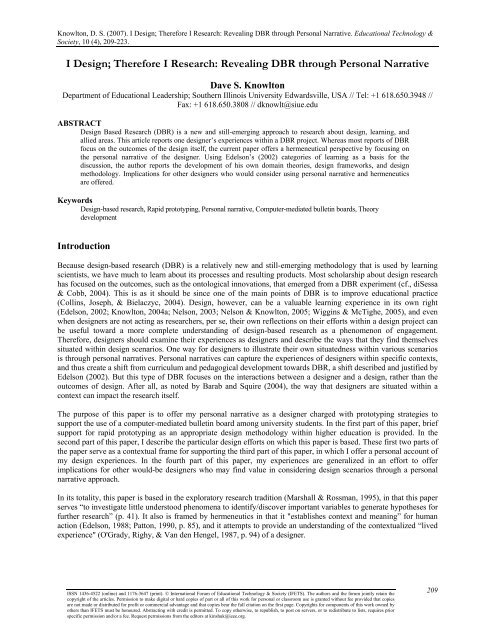October 2007 Volume 10 Number 4 - Educational Technology ...
October 2007 Volume 10 Number 4 - Educational Technology ...
October 2007 Volume 10 Number 4 - Educational Technology ...
Create successful ePaper yourself
Turn your PDF publications into a flip-book with our unique Google optimized e-Paper software.
Knowlton, D. S. (<strong>2007</strong>). I Design; Therefore I Research: Revealing DBR through Personal Narrative. <strong>Educational</strong> <strong>Technology</strong> &<br />
Society, <strong>10</strong> (4), 209-223.<br />
I Design; Therefore I Research: Revealing DBR through Personal Narrative<br />
Dave S. Knowlton<br />
Department of <strong>Educational</strong> Leadership; Southern Illinois University Edwardsville, USA // Tel: +1 618.650.3948 //<br />
Fax: +1 618.650.3808 // dknowlt@siue.edu<br />
ABSTRACT<br />
Design Based Research (DBR) is a new and still-emerging approach to research about design, learning, and<br />
allied areas. This article reports one designer’s experiences within a DBR project. Whereas most reports of DBR<br />
focus on the outcomes of the design itself, the current paper offers a hermeneutical perspective by focusing on<br />
the personal narrative of the designer. Using Edelson’s (2002) categories of learning as a basis for the<br />
discussion, the author reports the development of his own domain theories, design frameworks, and design<br />
methodology. Implications for other designers who would consider using personal narrative and hermeneutics<br />
are offered.<br />
Keywords<br />
Design-based research, Rapid prototyping, Personal narrative, Computer-mediated bulletin boards, Theory<br />
development<br />
Introduction<br />
Because design-based research (DBR) is a relatively new and still-emerging methodology that is used by learning<br />
scientists, we have much to learn about its processes and resulting products. Most scholarship about design research<br />
has focused on the outcomes, such as the ontological innovations, that emerged from a DBR experiment (cf., diSessa<br />
& Cobb, 2004). This is as it should be since one of the main points of DBR is to improve educational practice<br />
(Collins, Joseph, & Bielaczyc, 2004). Design, however, can be a valuable learning experience in its own right<br />
(Edelson, 2002; Knowlton, 2004a; Nelson, 2003; Nelson & Knowlton, 2005; Wiggins & McTighe, 2005), and even<br />
when designers are not acting as researchers, per se, their own reflections on their efforts within a design project can<br />
be useful toward a more complete understanding of design-based research as a phenomenon of engagement.<br />
Therefore, designers should examine their experiences as designers and describe the ways that they find themselves<br />
situated within design scenarios. One way for designers to illustrate their own situatedness within various scenarios<br />
is through personal narratives. Personal narratives can capture the experiences of designers within specific contexts,<br />
and thus create a shift from curriculum and pedagogical development towards DBR, a shift described and justified by<br />
Edelson (2002). But this type of DBR focuses on the interactions between a designer and a design, rather than the<br />
outcomes of design. After all, as noted by Barab and Squire (2004), the way that designers are situated within a<br />
context can impact the research itself.<br />
The purpose of this paper is to offer my personal narrative as a designer charged with prototyping strategies to<br />
support the use of a computer-mediated bulletin board among university students. In the first part of this paper, brief<br />
support for rapid prototyping as an appropriate design methodology within higher education is provided. In the<br />
second part of this paper, I describe the particular design efforts on which this paper is based. These first two parts of<br />
the paper serve as a contextual frame for supporting the third part of this paper, in which I offer a personal account of<br />
my design experiences. In the fourth part of this paper, my experiences are generalized in an effort to offer<br />
implications for other would-be designers who may find value in considering design scenarios through a personal<br />
narrative approach.<br />
In its totality, this paper is based in the exploratory research tradition (Marshall & Rossman, 1995), in that this paper<br />
serves “to investigate little understood phenomena to identify/discover important variables to generate hypotheses for<br />
further research” (p. 41). It also is framed by hermeneutics in that it "establishes context and meaning” for human<br />
action (Edelson, 1988; Patton, 1990, p. 85), and it attempts to provide an understanding of the contextualized “lived<br />
experience" (O'Grady, Righy, & Van den Hengel, 1987, p. 94) of a designer.<br />
ISSN 1436-4522 (online) and 1176-3647 (print). © International Forum of <strong>Educational</strong> <strong>Technology</strong> & Society (IFETS). The authors and the forum jointly retain the<br />
copyright of the articles. Permission to make digital or hard copies of part or all of this work for personal or classroom use is granted without fee provided that copies<br />
are not made or distributed for profit or commercial advantage and that copies bear the full citation on the first page. Copyrights for components of this work owned by<br />
others than IFETS must be honoured. Abstracting with credit is permitted. To copy otherwise, to republish, to post on servers, or to redistribute to lists, requires prior<br />
specific permission and/or a fee. Request permissions from the editors at kinshuk@ieee.org.<br />
209

















